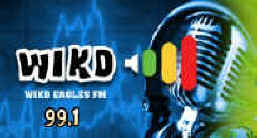|
History Of WIKD
Thanks to Daniel Chiericoni,
the WIKD-LP Technical Manager for this history of WIKD.
WIKD began as "The
Broadcast Club" in the Spring semester of 1990, initially chartered by
then-freshman Steve Graff. The first few meetings brought high
turnout (ca. 75 students), but did not immediately lead to much
organization. The club gained momentum after Graff met Todd Gumbrecht,
another freshman resident of the same dormitory (Doolittle Hall, then
known as Dorm II) as Graff. The two developed a strategy of "infiltration
and propaganda" in order to meet their goal of establishing a campus radio
station. The club became known for its fliers which were posted around
campus (often in unapproved locations) to announce club meetings, as this
was long before e-mail and text messaging and Facebook and
Twitter. The fliers were influenced by the DIY ethic of punk rock,
surrealism, 1950's clip art, science fiction, and "golden age" of radio. A
flier typically consisted of cut-and-pasted and defaced photographs from
magazines, and their graphic and provocative nature made them stand out
from other notices on campus.
The initial club logo was a stylized radio tower resembling the tower
symbol from an FAA sectional chart, with the letters "WERU" drawn
in a 1920's art deco type script. The radioactivity symbol became another
popular club logo later, appearing on buttons, t-shirts, and stickers.
With the preponderance of fliers, t-shirts, buttons, and stickers, some
students believed there actually already was an operating station on
campus. The club decided to
pursue the goal of carrier current broadcasting, and in the Spring of
1990, Graff and Gumbrecht traveled to NYC (on the SGA's dime) to attend a
convention of carrier current college stations hosted by equipment
manufacturer LPB. At this meeting, the pair obtained a copy of the UConn
station bylaws, which became the model for the broadcast club/WERU
organization. In 1991, Gumbrecht
became the SGA representative for students living in campus housing. In
addition to being a passionate advocate for dorm residents, Gumbrecht used
this platform to further the argument for the station, and to find allies
within the Student Government Association. Also, in 1991, the club
organization began to bloom, with Carrie Czernikowski as the
treasurer, author of the training manual, and eventual training director,
and Aaron Gee as the Chief Engineer.
Initially there was antipathy from the Dean of Students, the Student
Activities office, and the SGA toward the club and its goal of
establishing a radio station. This was due to the failure and dissolution
of a previous iteration of the broadcast club, involving theft of
equipment. The mischievous and defiant impression that the club gave off
at times may not have helped with this matter. However, the growing
popularity of the movement among students, and the dedication of its
members eventually overcame the aversion, and by 1992, "Campus Radio"
became a campaign issue in the SGA presidential race. While working toward the eventual goal
of a campus radio station, the club engaged in fundraising, publicity, and
charity events, such as providing mobile DJ services for student
organizations and Special Olympic events. These activities further
increased the club's exposure, and generated funding for a proposed
studio. The first WERU
studio was in a closet shared by the university cafeteria vendor,
Morrison's. At this point, the station broadcast via AM carrier current on
710AM. Eventually, the station moved operations to a closet in the McKay
Hall dormitory with a small mixing board and two CD players. WERU
later moved into a Student Government Association (SGA) office in the
Student Center (currently room UC-111). With upgraded facilities, and by
this time a full-fledged division of the SGA, WERU was initially
broadcasting on 104.7 MHZ through radiating cable FM on campus. After many
years of trials and tribulations from previous Chairmen, WERU 104.7 FM
had finally applied for a LPFM FCC license in 2002 thanks to SGA
President, Peter Alverez, and WERU Chairman, Patrick
"Nacho" Mudge. Shortly after application, "Nacho" left ERAU to be soon
followed by Chairman Greg Huston, who continued to pursue the
station's LPFM license. By the
Fall 2004 semester Division Chairpersons Jesse Lesperance and
David Yarwood had successfully completed the LPFM construction permit
application. In February 2005 WERU completed its first broadcast on
99.1 FM. WIKD then applied and was approved for their current call
letters as WIKD. On
Christmas Day 2006, an F2 tornado struck the Embry-Riddle Daytona
Beach Campus, which caused millions of dollars in damages, subsequently
damaging the radio station studio. Though the valiant work of many,
WIKD was quickly back up and running, and within 2 months was back to
a high broadcasting standard.
During the Winter break of 2011/2012 a team of WIKD members got to
work to give the radio station a much needed makeover, both aesthetically,
and technically. The implementation of a brand new Nautel VS300
transmitter with dynamic RDS capability was followed by a brand new
climate controlled 10x12' transmission shed. The studio itself was made
state of the art with complete Cat6 wiring and StudioHub+ implementation.
Furthermore new doors, ceiling tiles, paint job, desk carpet were
installed. 6 fiber optic lines were run to form the internal network
(WIKDNET) so that FTP and streaming services could be improved. Major
strides in programming rotation were made to suit the new studio changes
which include a CHR style rotation schedule. DJ's continue to bring
free-format variety to the station through their shows. In April 2012 the WIKD crew applied for a frequency change from 99.1 MHz to 102.5
MHz.
|
